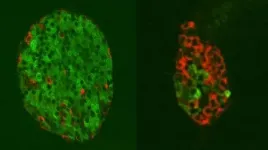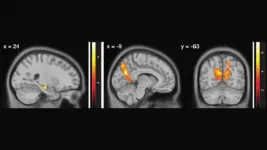(Press-News.org) March 1, 2021 - Benign bone tumors may be present in nearly 20 percent of healthy children, based on a review of historical radiographs in The Journal of Bone & Joint Surgery. The journal is published in the Lippincott portfolio in partnership with Wolters Kluwer.
Although that may sound frightening, non-ossifying fibromas and other common benign bone tumors in symptom-free children are harmless and may resolve over time, reports the new study by Christopher D. Collier, MD, of Indiana University School of Medicine and colleagues. "These findings provide unique evidence to answer many commonly encountered questions when counseling patients and their families on benign bone tumors," the researchers write.
Study offers reassurance that benign bone tumors in healthy children are harmless
Benign bone tumors are commonly detected in children incidentally on radiographs made for other reasons. Although some benign childhood bone tumors are classified as active or aggressive, these are usually discovered when they cause discomfort or pathologic fracture (caused by underlying disease).
When latent benign bone tumors are discovered incidentally in an asymptomatic child, the child is usually evaluated by a specialist, such as a pediatric orthopaedic surgeon or orthopaedic oncologist. For some specialists, children with benign tumors account for more than half of new patients.
"Understandably, these tumors cause a lot of anxiety for patients and families as they await confirmation that the tumor is benign," Dr. Collier says. "They need reassurance and often ask how common these tumors are, when did they first appear, and whether they will resolve over time? We don't have much evidence to date to address these questions."
The researchers analyzed a unique collection of radiographs from a study called the Brush Inquiry, in which a series of healthy, "normal" children in Cleveland, Ohio, underwent annual radiographs from 1926 to 1942. Although the Brush Inquiry provided valuable information on skeletal growth and development in children, such a study couldn't be performed today for ethical reasons, now that the risks of radiation exposure are recognized.
Close to a century later, the Brush Inquiry radiographs provide a unique opportunity to identify benign bone tumors and their outcomes over several years of follow-up. Dr. Collier and colleagues analyzed a total of 25,555 digitized radiographs in 262 children, followed from infancy to adolescence.
The results confirmed the high prevalence of benign bone tumors. A total of 35 benign bone tumors were found in 33 children - an overall rate of 18.9 percent when considering that only the left side of the children was radiographed.
More than half of the tumors were a type called non-ossifying fibromas, which are masses of connective tissue that have not hardened into bone. These fibromas tended to appear around age five, with another peak around the time of skeletal maturation, possibly related to changing growth rates. Of 19 non-ossifying fibromas detected, seven disappeared over time. Others may have resolved in the years after the children stopped undergoing annual radiographs.
Less-common benign bone tumors included enostoses, sometimes called "bone islands"; and osteochondromas or enchondromas, representing areas of abnormal but harmless cartilage growth. These tumors persisted through the last-available radiographs in all patients who had them.
The findings are generally consistent with previous studies of the rates of benign bone tumors in healthy adults. It is one of the first studies of benign bone tumors in children, and the only one to provide longitudinal follow-up, including the age at first appearance. Dr. Collier adds: "Despite the inherent limitations of our historical study, it may provide the best available evidence regarding the natural history of asymptomatic benign childhood bone tumors."
Click here to read "The Natural History of Benign Bone Tumors of the Extremities in Asymptomatic Children: A Longitudinal Radiographic Study."
DOI: 10.2106/JBJS.20.00999
INFORMATION:
About The Journal of Bone & Joint Surgery
The Journal of Bone & Joint Surgery (JBJS) has been the most valued source of information for orthopaedic surgeons and researchers for over 125 years and is the gold standard in peer-reviewed scientific information in the field. A core journal and essential reading for general as well as specialist orthopaedic surgeons worldwide, The Journal publishes evidence-based research to enhance the quality of care for orthopaedic patients. Standards of excellence and high quality are maintained in everything we do, from the science of the content published to the customer service we provide. JBJS is an independent, non-profit journal.
About Wolters Kluwer
Wolters Kluwer (WKL) is a global leader in professional information, software solutions, and services for the clinicians, nurses, accountants, lawyers, and tax, finance, audit, risk, compliance, and regulatory sectors. We help our customers make critical decisions every day by providing expert solutions that combine deep domain knowledge with advanced technology and services.
Wolters Kluwer reported 2019 annual revenues of €4.6 billion. The group serves customers in over 180 countries, maintains operations in over 40 countries, and employs approximately 19,000 people worldwide. The company is headquartered in Alphen aan den Rijn, the Netherlands.
Wolters Kluwer provides trusted clinical technology and evidence-based solutions that engage clinicians, patients, researchers and students with advanced clinical decision support, learning and research and clinical intelligence. For more information about our solutions, visit https://www.wolterskluwer.com/en/health and follow us on LinkedIn and Twitter @WKHealth.
For more information, visit http://www.wolterskluwer.com, follow us on Twitter, Facebook, LinkedIn, and YouTube.
Blocking cell receptors for glucagon, the counter-hormone to insulin, cured mouse models of diabetes by converting glucagon-producing cells into insulin producers instead, a team led by UT Southwestern reports in a new study. The END ...
Boston, MA--Most pregnant women and mothers of children younger than 18 years old say they would receive a COVID-19 vaccine and vaccinate their children, according to a survey conducted by researchers at Harvard T.H. Chan School of Public Health. The research indicated that vaccine acceptance was highest in India, the Philippines, and all sampled countries in Latin America, and it was lowest in Russia, the U.S., and Australia.
The results will be published online on March 1, 2021 in the European Journal of Epidemiology.
Vaccines for COVID-19 are being distributed around the world, but until ...
SILVER SPRING, Md. - A recent preclinical study by U.S. Military HIV Research Program (MHRP) researchers showed that an experimental therapy combining a TLR7 agonist and two broadly neutralizing antibodies delayed viral rebound in SHIV-infected macaques after antiretroviral therapy (ART) interruption.
The experimental combination therapy consisted of TLR7 agonist GS-986 and two broadly neutralizing antibodies (bnAbs), N6-LS and PGT121, targeting different regions of the HIV envelope. The rhesus macaques were initiated on viral suppressive antiretroviral therapy 14 days post infection, a timespan from infection to treatment which mirrors what is feasible in acute HIV infection. Researchers then administered the experimental combination ...
NEW YORK, NY (March 1, 2021)--By harnessing the immune system against cancer, immunotherapies have revolutionized the way some types of cancer are treated. But most patients--across cancer types--do not respond, and in most cases, scientists are at a loss as to why.
Researchers at Columbia and MIT have created a new technique that can uncover nearly all of the tricks cancer cells use to evade immunotherapies, which could lead to the development of more effective treatments.
The researchers tested their new technique with cancer cells and matching immune cells from melanoma patients and identified previously unknown resistance mechanisms to immune checkpoint ...
Black Americans have a high level of vaccine hesitancy and mistrust of COVID-19 vaccines, including among Black health care workers, according to a new RAND Corporation survey.
Those who expressed vaccine hesitancy also showed high levels of overall mistrust in the vaccine, concerns about potential harm and side effects, and lack of confidence in vaccine effectiveness and safety.
Participants in the RAND survey reported higher trust in COVID-19 information from health care providers and public health officials than from elected local and federal officials.
The findings are based on a survey ...
Tissue engineering has long-depended on geometrically static scaffolds seeded with cells in the lab to create new tissues and even organs. The scaffolding material -- usually a biodegradable polymer structure -- is supplied with cells and the cells, if supplied with the right nutrients, then develop into tissue as the underlying scaffold biodegrades. But this model ignores the extraordinarily dynamic morphological processes that underlie the natural development of tissues.
Now, researchers at the END ...
A team of international researchers led by a Florida State University assistant professor has analyzed reams of data from the Neolithic to Late Roman period looking at migration patterns across the Mediterranean and found that despite evidence of cultural connections, there's little evidence of massive migration across the region.
"Because of the prevailing scholarly attitude of the 'connected' Mediterranean -- one with high degrees of mobility and migration that drive the archaeological patterns we see -- we'd imagined we'd see comparatively high levels of migration reflected in the strontium isotope data," said Thomas Leppard, assistant professor of anthropology at Florida State. "That instead ...
Invasive alien species, defined as animals and plants that breed and disperse in a landscape beyond their native range, have negative environmental, social, and economic impacts. One example among many is the forage grass genus Brachiaria, originally African and introduced to Brazil to form cattle pasture. It has become a major threat to the survival of native species and biodiversity at several spatial scales.
Complete eradication of invasive species is often impracticable. Attempts to do so have had undesirable consequences and even been damaging because merely withdrawing an invasive ...
Too much activity in the hippocampus may cause navigation impairments seen in aging adults, according to new research published in JNeurosci.
Spatial navigation is one of the cognitive abilities that declines sharply in old age. Older adults often have difficulty navigating new environments and will choose to stick with familiar ones. Plus, key regions in the brain's navigation circuit are some of the first affected by Alzheimer's disease. In a recent study, Diersch et al. examined the neural mechanism behind this decline in spatial learning.
In the study, younger ...
A single letter difference in a single gene, inherited from both parents, spells a lifetime of anemia and pain for 20 million people, mostly of African ancestry, worldwide. Sickle cell disease (SCD) causes red blood cells to assume a sickle shape and jam in capillaries, cutting off oxygen to lungs, brain, bones and other organs. Despite the single genetic origin of SCD, each person's disease experience and even life expectancy depend upon where they live, and the social, physical and environmental factors they encounter.
Now, a new review published by Wiley in the journal Advanced Genetics proposes that it is ...




